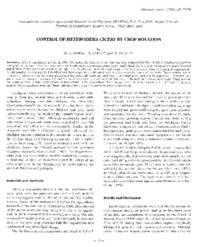Control of Heterodera Ciceri by Crop rotation

Authors:
A field experiment in Syria in 1986-1991 tested the efficacy of six four-year crop rotations for the control of Heterodera ciceri on chickpea and grasspea. Crop sequences included cultivation of non-host crops (barley and wheat) for 0, 1, 2 or 3 consecutive years. The soil populations of the nematode remained at high levels in plots planted with host crops every year or every other year (max 63 eggs/g soil), but declined to 43-63% and 12-16% when non-host crops were cultivated for 1 or 2-3 consecutive years, respectively. The nematode reproduction rate decreased as the soil population of the nematode increased and was 17 at 2 eggs/g soil and 3 at 14 eggs/g soil. Biological and grain yields of grasspea increased 1.1 and 2.6 times, respectively, when no host plant was cultivated for 2 consecutive years. Chickpea was destroyed by frost in March 1990; hence it was resown in the next season. The chickpea seed yields increased by 2.1, 4.5 and 7.9 times in plots in which non-host crops had been cultivated for 1, 2 or 3 consecutive years, respectively.
